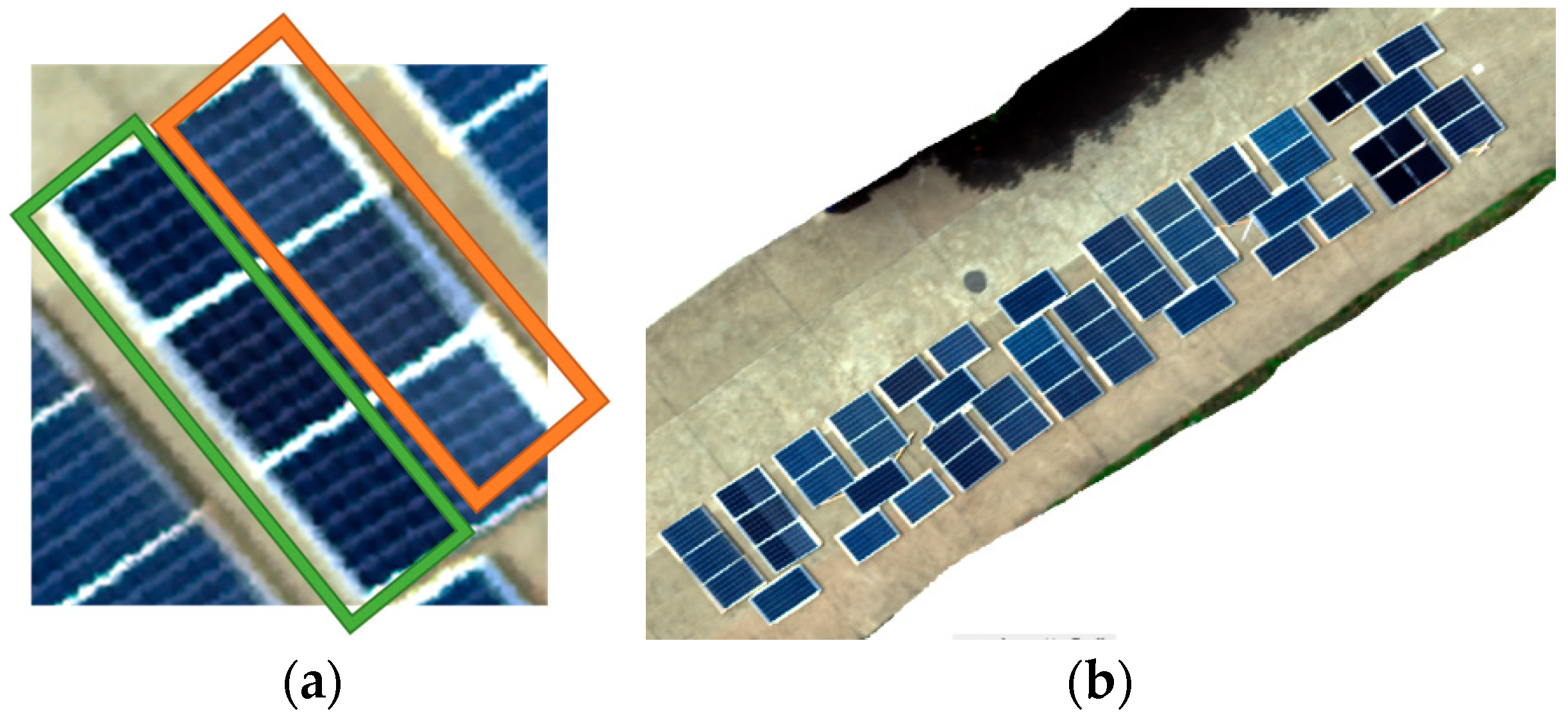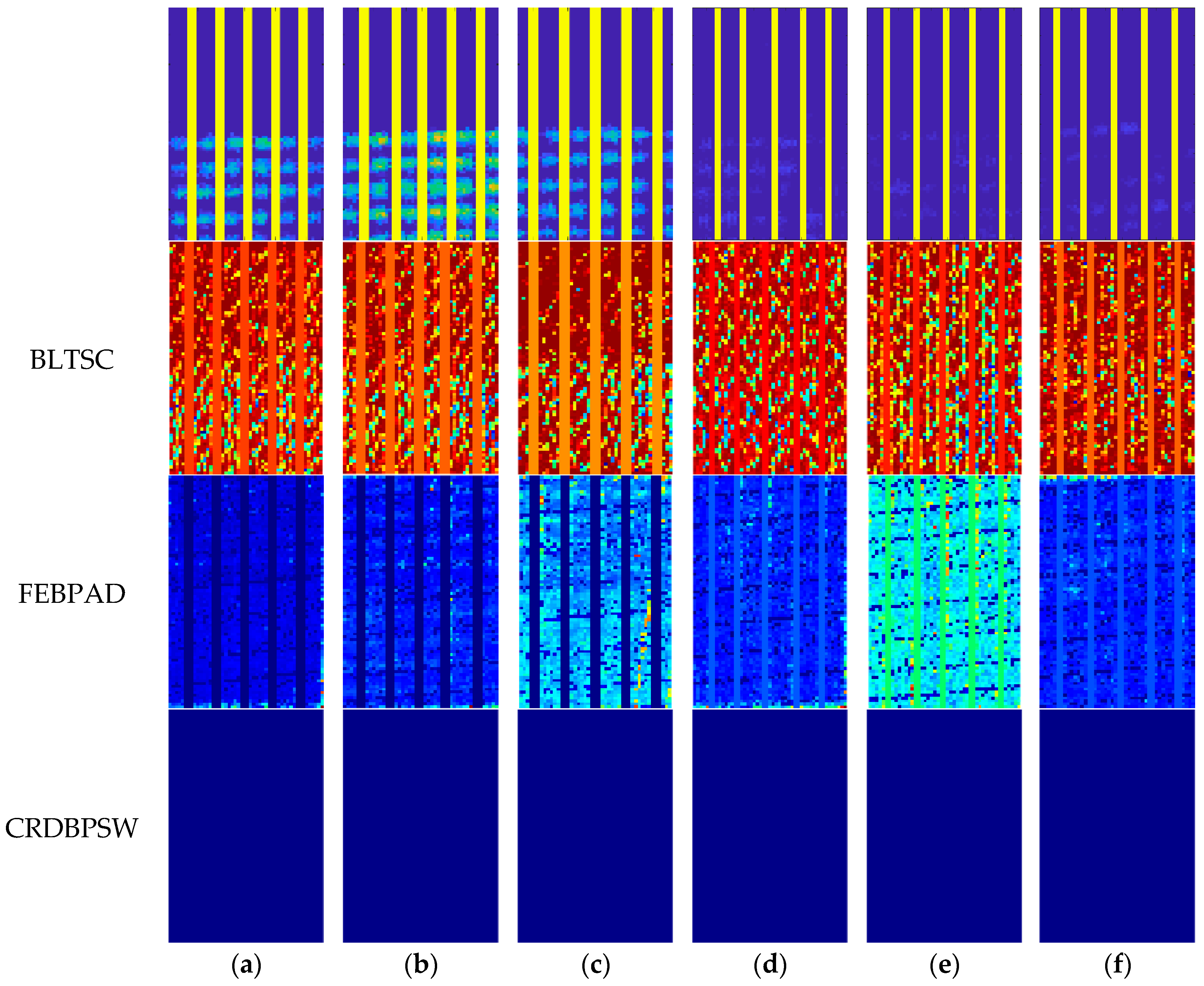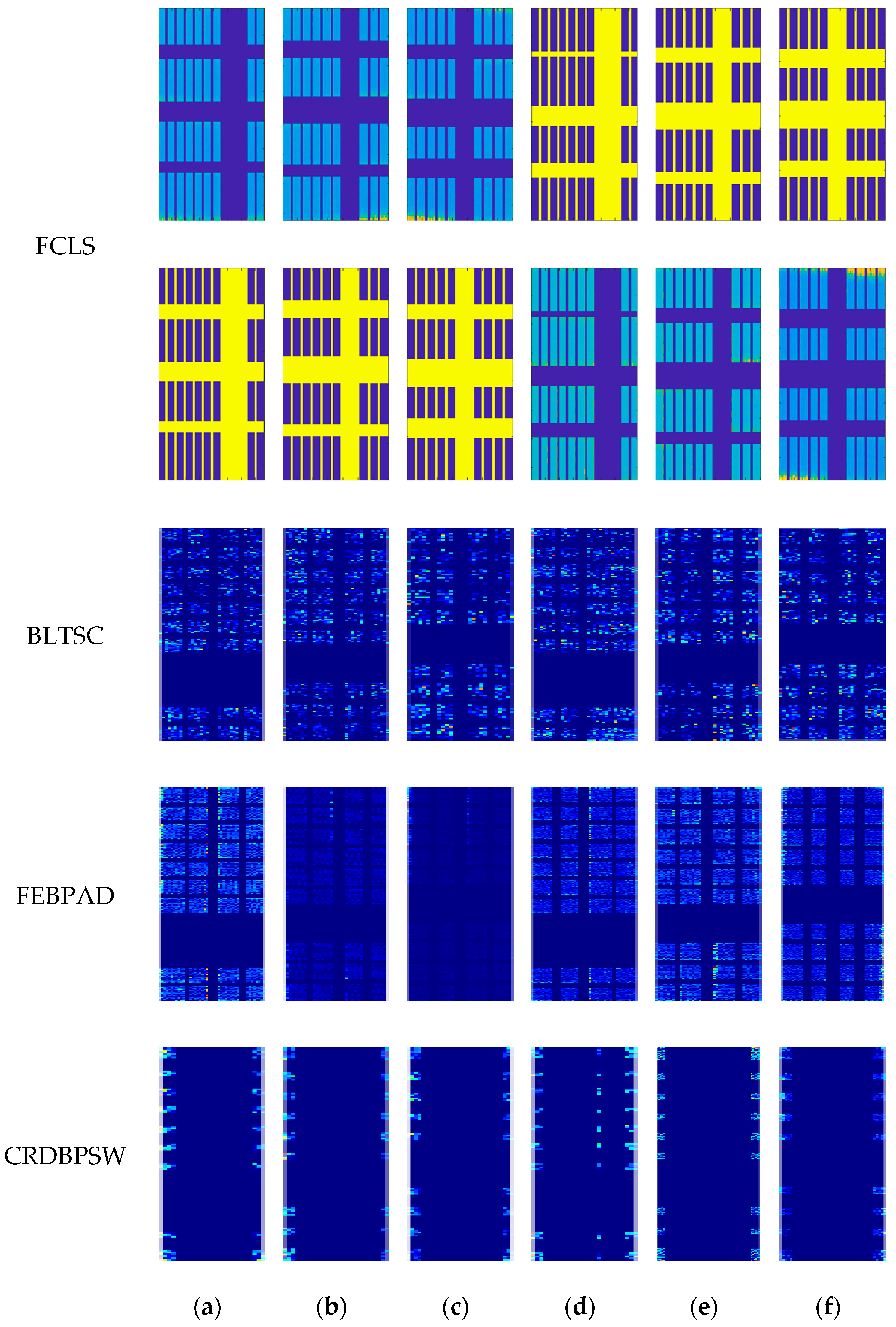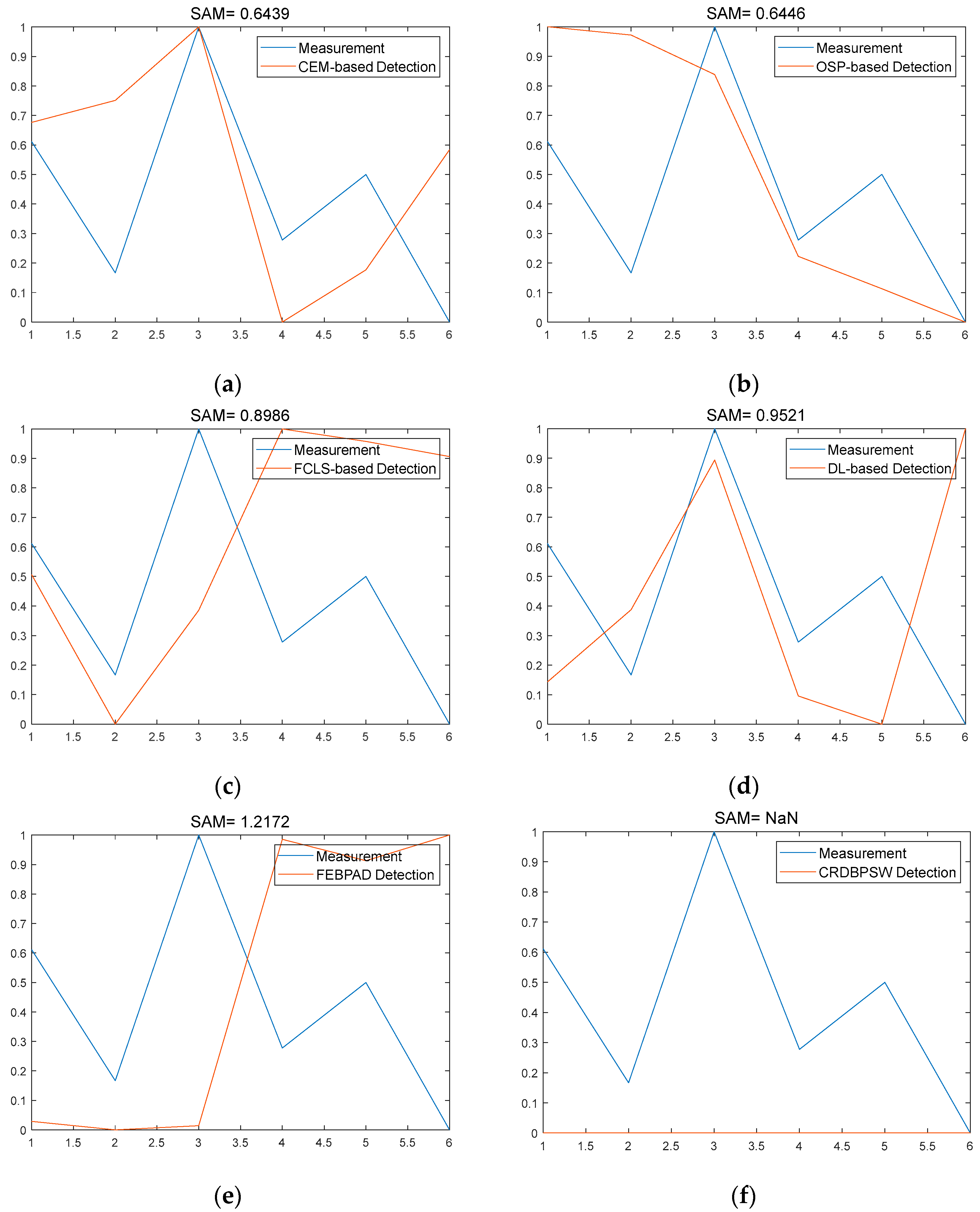Stain Detection Based on Unmanned Aerial Vehicle Hyperspectral Photovoltaic Module
Abstract
:1. Introduction
- (1)
- A stain detection framework based on an HSI PV module is proposed to address the challenges posed by various type of stains, large stains, and unknown spectral signatures. The framework consists of two detection methods: constrained energy minimization-based and orthogonal subspace projection-based methods.
- (2)
- The relationship between the amount of stains accumulated by the spectral module and the power generation efficiency of the PV module is modeled. The results demonstrate that the developed method achieves comparable performance with the electroluminescence (EL) image-based stain detection technology.
2. Methods
2.1. Remove Irrelevant Interference
2.1.1. Remove Gridlines
2.1.2. Data Correction
2.2. Method Introduction
2.2.1. Stain Detection of HSI PV Module Based on CEM
2.2.2. Stain Detection of HSI PV Module Based on OSP
3. Experimental Results and Analysis
3.1. Relationship between the Detection Results of Different Methods and Percentage of Stain
3.2. Comparison of EL Image-Based and HSI-Based Experimental Results
4. Discussion
5. Conclusions
Author Contributions
Funding
Data Availability Statement
Conflicts of Interest
References
- Zhao, E.; Li, L.; Song, M.; Cao, Y.; Chen, S.; Shang, X.; Li, F.; Dai, S.; Bao, H. Research on image registration algorithm and its application in photovoltaic images. IEEE J. Photovolt. 2020, 10, 595–606. [Google Scholar] [CrossRef]
- Ravishankar, R.; AlMahmoud, E.; Habib, A.; de Weck, O.L. Capacity estimation of solar farms using deep learning on high-resolution satellite imagery. Remote Sens. 2023, 15, 210. [Google Scholar] [CrossRef]
- SolarBe, News. Overview of the Photovoltaic Industry’s Development in the Past Three Years and Future Trends. Available online: https://news.solarbe.com/202308/23/371119.html (accessed on 23 August 2023).
- Xu, X.-B.; Zhang, H.-J.; Bai, J.-B.; Pei, R.H.; Hu, J.Y.; Tan, Z.Y. High-precision segmentation method for distributed photovoltaic buildings based on improved unet. J. Sol. Energy 2023, 44, 82–90. [Google Scholar]
- Zhang, Y.; Qin, W.; Wang, L.; Yang, C.; Su, X.; Wu, J. Enhancement of photovoltaic power potential in China from 2010 to 2020: The contribution of air pollution control policies. Remote Sens. 2022, 15, 228. [Google Scholar] [CrossRef]
- Jumaboev, S.; Jurakuziev, D.; Lee, M. Photovoltaics plant fault detection using deep learning techniques. Remote Sens. 2022, 14, 3728. [Google Scholar] [CrossRef]
- Zhang, F.; Bai, J.B.; Hao, Y.Z.; Zhang, Z.; Jiang, M. Effect of airborne dust deposition on PV module surface on its power generation performance. Power Grid Clean Energy 2012, 28, 5. [Google Scholar]
- Wang, P.; Du, W.; Zhang, H.N.; Li, C. Pollution impact on the leakage current and power degradation of photovoltaic modules. Acta Energiae Solaris Sin. 2019, 40, 7. [Google Scholar]
- Jiang, H.; Lu, L.; Sun, K. Experimental investigation of the impact of airborne dust deposition on the performance of solar photovoltaic (PV) modules. Atmos. Environ. 2011, 45, 4299–4304. [Google Scholar] [CrossRef]
- Zaihidee, F.M.; Mekhilef, S.; Seyedmahmoudian, M.; Horan, B. Dust as an unalterable deteriorative factor affecting PV panel’s efficiency: Why and how. Renew. Sustain. Energy Rev. 2016, 65, 1267–1278. [Google Scholar] [CrossRef]
- Mekhilef, S.; Rahman, S.; Kamalisarvestani, M. Effect of dust, humidity and air velocity on efficiency of photovoltaic cells. Renew. Sustain. Energy Rev. 2012, 16, 2920–2925. [Google Scholar] [CrossRef]
- Kaldellis, J.K.; Kapsali, M. Simulating the dust effect on the energy performance of photovoltaic generators based on experimental measurements. Energy 2011, 36, 5154–5161. [Google Scholar] [CrossRef]
- Kazem, H.A.; Al-Bahri, S.; Al-Badi, S.; Al-Mahkladi, H. Effect of dust on photovoltaic performance. Adv. Mater. Res. 2014, 875–877, 1908–1911. [Google Scholar] [CrossRef]
- Wen, W.; Li, S.; Zhou, F.; Li, M.; Xie, Q.; Chen, S. Stain detection method of solar panel based on spot elimination. In Proceedings of the Big Data, Artificial Intelligence and Internet of Things Engineering, Nanchang, China, 26–28 March 2021. [Google Scholar]
- Li, T.; Yang, D.; Chen, C.; Zeng, Z.; Huang, G.; Tao, B.; Li, J. A mobile robot design for efficient and large-scale solar panel cleaning. In Proceedings of the IEEE International Conference on Robotics and Biomimetics, Xishuangbanna, China, 5–9 December 2022. [Google Scholar]
- Hegazy, A.A. Effect of dust accumulation on solar transmittance through glass covers of plate-type collectors. Renew. Energy 2001, 22, 525–540. [Google Scholar] [CrossRef]
- Kaldellis, J.K.; Kokala, A. Quantifying the decrease of the photovoltaic panels’ energy yield due to phenomena of natural air pollution disposal. Energy 2010, 35, 4862–4869. [Google Scholar] [CrossRef]
- Mani, M.; Pillai, R.; Lee, M. Impact of dust on solar photovoltaic (PV) performance: Research status, challenges and recommendations. Renew. Sustain. Energy Rev. 2010, 14, 3124–3131. [Google Scholar] [CrossRef]
- Nurjanah, S.; Dewi, T. Dusting and Soiling Effect on PV Panel Performance: Case Study Open-pit Mining in South Sumatra. Indonesia. In Proceedings of the International Conference on Electrical and Information Technology, Malang, Indonesia, 14–15 September 2021. [Google Scholar]
- Amr, L.; Abdellatif, S.O.; Kirah, K.; Ghali, H.A. Investigating the optical impact of an effective time-dependent dust accumulation layer on the optoelectronic performance of monocrystalline solar cell. In Proceedings of the International Conference on Green Energy, Computing and Sustainable Technology, Miri, Sarawak, Malaysia, 7–9 July 2021. [Google Scholar]
- Fan, S.; Wang, X.; Cao, S.; Wang, Y.; Zhang, Y.; Liu, B. A novel model to determine the relationship between dust concentration and energy conversion efficiency of photovoltaic (PV) panels. Energy 2022, 252, 123927. [Google Scholar] [CrossRef]
- Rekioua, D.; Matagne, E. Optimization of Photovoltaic Power Systems: Modelization, Simulation and Control; Springer Science & Business Media: Berlin, Germany, 2012. [Google Scholar]
- Xingcai, L.; Kun, N. Effectively predict the solar radiation transmittance of dusty photovoltaic panels through Lambert-Beer law. Renew. Energy 2018, 123, 634–638. [Google Scholar] [CrossRef]
- Jha, S.S.; Joshi, C.; Nidamanuri, R.R. Target Detection in Hyperspectral Imagery Using Atmospheric-Spectral Modeling and Deep Learning. IEEE Geosci. Remote Sens. Lett. 2022, 19, 1–5. [Google Scholar] [CrossRef]
- Chang, C.-I.; Schultz, R.C.; Hobbs, M.C.; Chen, S.Y.; Wang, Y.; Liu, C. Progressive band processing of constrained energy minimization for subpixel detection. IEEE Trans. Geosci. Remote Sens. 2015, 53, 1626–1637. [Google Scholar] [CrossRef]
- Harsanyi, J.C.; Chang, C.-I. Hyperspectral image classification and dimensionality reduction: An orthogonal subspace projection approach. IEEE Trans. Geosci. Remote Sens. 1994, 32, 779–785. [Google Scholar] [CrossRef]
- Chang, C.-I.; Cao, H.; Chen, S.; Shang, X.; Yu, C.; Song, M. Orthogonal subspace projection-based go-decomposition approach to finding low-rank and sparsity matrices for hyperspectral anomaly detection. IEEE Trans. Geosci. Remote Sens. 2021, 59, 2403–2429. [Google Scholar] [CrossRef]
- Song, M.; Li, L.; Chen, S.; Dai, S.; Li, F. Photovoltaic image registration based on feature matching via guided spatial consensus. IEEE J. Photovolt. 2021, 5, 1118–1125. [Google Scholar] [CrossRef]
- Heinz, D.; Chang, C.-I. Fully constrained least squares linear mixture analysis for material quantification in hyperspectral imagery. IEEE Trans. Geosci. Remote Sens. 2001, 39, 529–545. [Google Scholar] [CrossRef]
- Xie, W.; Zhang, X.; Li, Y.; Wang, K.; Du, Q. Background learning based on target suppression constraint for hyperspectral target detection. IEEE J. Sel. Top. Appl. Earth Obs. Remote Sens. 2020, 13, 5887–5897. [Google Scholar] [CrossRef]
- Hou, Z.; Li, W.; Tao, R.; Ma, P.; Shi, W. Collaborative representation with background purification and saliency weight for hyperspectral anomaly detection. Sci. China Inf. Sci. 2022, 65, 112305. [Google Scholar] [CrossRef]
- Ma, Y.; Fan, G.; Jin, Q.; Huang, J.; Mei, X.; Ma, J. Hyperspectral anomaly detection via integration of feature extraction and background purification. IEEE Geosci. Remote Sens. Lett. 2021, 18, 1436–1440. [Google Scholar] [CrossRef]











| CEM | OSP | FCLS | DL | FEBPAD | CRDBPSW | |
|---|---|---|---|---|---|---|
| SAM | 0.6439 | 0.6446 | 0.8986 | 0.9521 | 1.2172 | NaN |
| PS (%) | 3.9 | 3.1 | 4.6 | 3.3 | 3.7 | 2.8 |
|---|---|---|---|---|---|---|
| CEM-based | 3.0709 | 3.1594 | 3.4536 | 2.2714 | 2.4803 | 2.9618 |
| OSP-based | 0.0602 | 0.0595 | 0.0562 | 0.0410 | 0.0383 | 0.0355 |
| EL1 | 2.9500 | 3.5500 | 7.8500 | 2.5300 | 4.3300 | 5.5500 |
| EL2 | 0.5600 | 0.5700 | 0.6400 | 0.0500 | 0.2400 | 0.2400 |
Disclaimer/Publisher’s Note: The statements, opinions and data contained in all publications are solely those of the individual author(s) and contributor(s) and not of MDPI and/or the editor(s). MDPI and/or the editor(s) disclaim responsibility for any injury to people or property resulting from any ideas, methods, instructions or products referred to in the content. |
© 2023 by the authors. Licensee MDPI, Basel, Switzerland. This article is an open access article distributed under the terms and conditions of the Creative Commons Attribution (CC BY) license (https://creativecommons.org/licenses/by/4.0/).
Share and Cite
Li, D.; Li, L.; Cui, M.; Shi, P.; Shi, Y.; Zhu, J.; Dai, S.; Song, M. Stain Detection Based on Unmanned Aerial Vehicle Hyperspectral Photovoltaic Module. Remote Sens. 2024, 16, 153. https://doi.org/10.3390/rs16010153
Li D, Li L, Cui M, Shi P, Shi Y, Zhu J, Dai S, Song M. Stain Detection Based on Unmanned Aerial Vehicle Hyperspectral Photovoltaic Module. Remote Sensing. 2024; 16(1):153. https://doi.org/10.3390/rs16010153
Chicago/Turabian StyleLi, Da, Lan Li, Mingyang Cui, Pengliang Shi, Yintong Shi, Jian Zhu, Sui Dai, and Meiping Song. 2024. "Stain Detection Based on Unmanned Aerial Vehicle Hyperspectral Photovoltaic Module" Remote Sensing 16, no. 1: 153. https://doi.org/10.3390/rs16010153
APA StyleLi, D., Li, L., Cui, M., Shi, P., Shi, Y., Zhu, J., Dai, S., & Song, M. (2024). Stain Detection Based on Unmanned Aerial Vehicle Hyperspectral Photovoltaic Module. Remote Sensing, 16(1), 153. https://doi.org/10.3390/rs16010153






